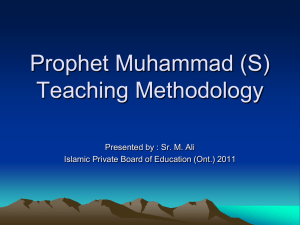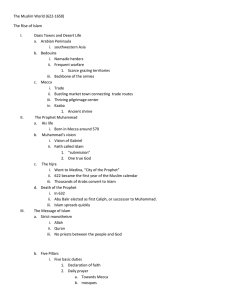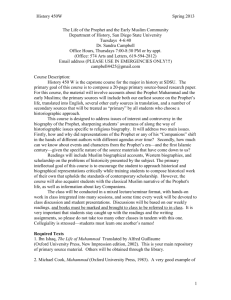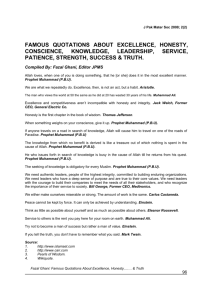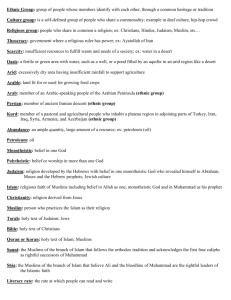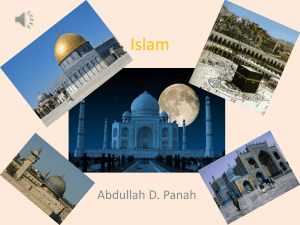Lecture 5
advertisement
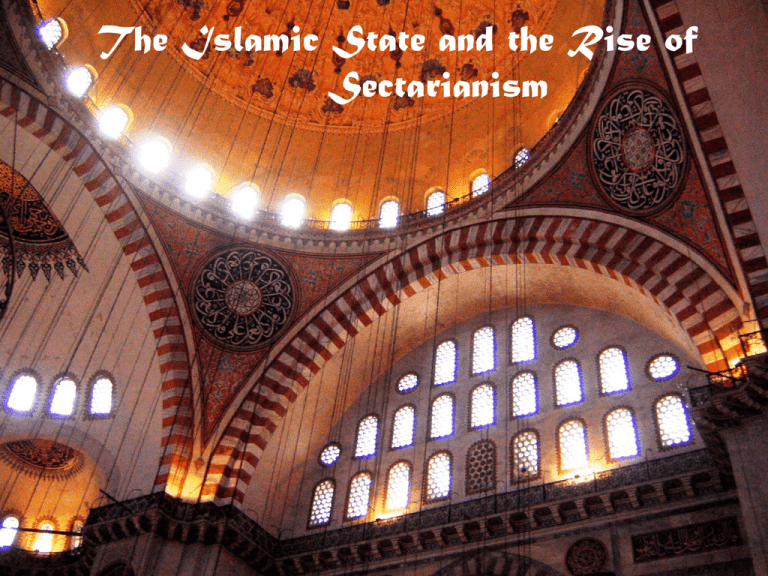
The Islamic State and the Rise of Sectarianism How Muslim History is Written? Stories about the Prophet are transmitted, sometimes orally, sometimes in rough written form, until they are set down in books that survive until today. The stories about the life of the Prophet come from Ibn Ishaq’s Sira (biography), but they represent lots of different stories told about the Prophet and then gathered together by Ibn Ishaq. A Possible Hadith…. The Isnad The report W reported from X, who reported from Y, who heard from Z, who heard the Prophet say: “Don’t put your feet on the table!” The Power of Context Abbas: the Prophet’s uncle… he never emigrates to Medina and doesn’t “announce” his being Muslim until the eve of the Muslim conquest of Mecca. Abbas: the ancestor of the Abbasid dynasty and their tie to the family of the Prophet The Authority of the Prophet in Medina Religious: absolute authority • Muhammad defines Islam – ‘No god but God, Muhammad is the Prophet of God – He defines Islam doctrinally and legally – His person symbolizes the faith: slander= treason Political: authority… but absolute? • Muhammad is God’s only legitimate representative • Decisions are arrived at through council, but Muhammad decides. • Instances of Quran agreeing with Umar How do we know any of this is true? Question: if early Islamic history is written down in a time when Muslims are fighting amongst themselves and defining their position in terms of other religions… what is true? Maybe the whole story is made up? Answer 1. Who carried out this conspiracy? 2. Even Christian sources tell us about Islam and Muhammad: 1. Doctrina Jacobi wr. 634: Arab prophet claims he has the keys to Paradise 2. John of Phenak (wr. 687) says that Muhammad is ‘guide’ and ‘instructor’ who taught the Arabs to “worship the One God in accordance with ancient law.” “they kept to the tradition of Muhammad” to the extent that they killed people who brazenly broke with his law. 3. Inscription by Umayyad al-Walid on Damascus mosque from 706 CE “Our lord is One God, our religion is Islam and our Prophet Muhammad” Who Inherits the Prophet’s Religious Authority? 1. The community does?… since the Prophet said (example of a hadith) that “My community will never agree on an error.” Sunni Answer 2. The most pious? Kharijite answer. 3. The family of the Prophet? The Shiite answer Who Inherits the Prophet’s Political Authority? 1. The community does… whomever the community accepts is acceptable Sunni Answer… pragmatic, unity, injustice is better than chaos. 2. The most pious? Kharijite answer… great idea, but has auto-immune problem. - Ibadis: modern Kharijites in Oman, Algeria 3. The family of the Prophet? The Shiite answer… repeated failures, then what? Early Shiism and a Call for the Just Rule of Islam Umayyad Dynasty (r. 660-750): the old Meccan elite return in Muslim clothes! Rebellions led by pious Muslims (Ibn alZubayr and the 2nd Civil War) and then by descendents of Muhammad: Husayn (d. 680), Zayd b. Ali (d. 740), Muhammad ‘The Pure Soul’ (d. 762) The ‘Abbasid Revolution (750CE): “return to the Sunna of the Prophet… rule by the family of the Prophet.” Reality: Sassanid Empire Strikes Back • Caliph as ‘Shadow of God’ on earth – New imperial city of Baghdad, “The City of Peace”, built near old Sassanid capital of Ctesiphon… a round city with caliph’s palace at center. – Apocalyptic and Pious Caliphal Names: • Al-Mahdi: the Messianic rightly-guided etc. • Circle of Justice: ruler maintains justice above all, Near Eastern political advice literature translated into Arabic The Sunni Compromise • Caliph must be from Quraysh and able: not necessarily the best, the most pious, or selected by community • The Caliph’s chief objective is to maintain order and allow the scholars (ulama) to apply Islamic legal system (Shariah) • Injustice is better than anarchy; legitimizing order is better than demanding confusion back Surviving vault of the Sassanid palace at Ctesiphon – near Baghdad back Surviving vestiges of Abbasid Palace - Baghdad back
